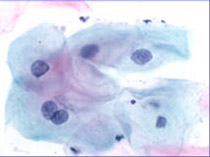
Vaccines are commonly used to prevent diseases such as measles, mumps, and polio. In addition to preventing sickness, cancer researchers want to capitalize on the ability of vaccines to stimulate the body’s immune system to mount an assault on existing cancer cells.
In this issue, BenchMarks examines prevention and treatment cancer vaccines. A fact sheet provides the latest information on how cancer vaccines are being made, which are furthest along in testing, and what cancers are being targeted. To get a better picture of how cancer vaccines work, click on the animation, which shows how immune cells are activated to attack foreign invaders. The main BenchMarks article is an interview with Douglas Lowy, M.D., from the National Cancer Institute (NCI) who has developed the technology underlying the prevention vaccine for human papillomavirus (HPV), which causes cervical cancer. Lowy, along with other NCI vaccine researchers, also spoke at a Science Writers Seminar on March 21, 2003 (PowerPoint presentations are available, and a video archive of the seminar can be found at http://videocast.nih.gov). BenchMarks has provided a soundbite from Lowy’s BenchMarks interview, which can be found at the audio clips button. And stills from the animation are also available.
 NCI NewsCenter
NCI NewsCenter NCI Budget Data
NCI Budget Data Visuals Online
Visuals Online NCI Fact Sheets
NCI Fact Sheets Understanding Cancer Series
Understanding Cancer Series